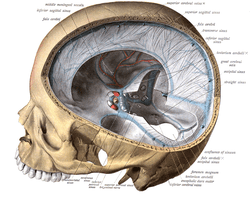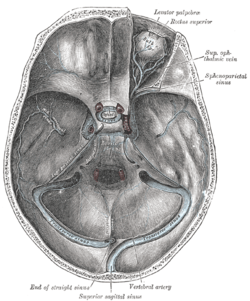Dural venous sinuses
The dural venous sinuses (also called dural sinuses, cerebral sinuses, or cranial sinuses) are venous channels found between the endosteal and meningeal layers of dura mater in the brain.[1][2] They receive blood from the cerebral veins, receive cerebrospinal fluid (CSF) from the subarachnoid space via arachnoid granulations, and mainly empty into the internal jugular vein.[2]
| Dural venous sinuses | |
|---|---|
 Illustration of the dural venous sinuses | |
 Dural venous sinuses | |
| Details | |
| Identifiers | |
| Latin | Sinus durae matris |
| MeSH | D003392 |
| TA | A12.3.05.101 |
| FMA | 76590 |
| Anatomical terminology | |
Venous sinuses
| Name | Drains to |
| Anterior | |
| Sphenoparietal sinuses | Cavernous sinuses |
| Cavernous sinuses | Superior and inferior petrosal sinuses |
| Midline | |
| Superior sagittal sinus | Typically becomes right transverse sinus or confluence of sinuses |
| Inferior sagittal sinus | Straight sinus |
| Straight sinus | Typically becomes left transverse sinus or confluence of sinuses |
| Posterior | |
| Occipital sinus | Confluence of sinuses |
| Confluence of sinuses | Right and Left transverse sinuses |
| Lateral | |
| Superior petrosal sinus | Transverse sinuses |
| Transverse sinuses | Sigmoid sinus |
| Inferior petrosal sinus | Internal jugular vein |
| Sigmoid sinuses | Internal jugular vein |
Structure
The walls of the dural venous sinuses are composed of dura mater lined with endothelium, a specialized layer of flattened cells found in blood vessels. They differ from other blood vessels in that they lack a full set of vessel layers (e.g. tunica media) characteristic of arteries and veins. It also lacks valves (in veins; with exception of materno-fetal blood circulation i.e. placental artery and pulmonary arteries both of which carry deoxygenated blood).
Clinical relevance
The sinuses can be injured by trauma in which damage to the dura mater, may result in blood clot formation (thrombosis) within the dural sinuses. Other common causes of dural sinus thrombosis include tracking of infection through the ophthalmic vein in orbital cellulitis. While rare, dural sinus thrombosis may lead to hemorrhagic infarction or cerebral oedema with serious consequences including epilepsy, neurological deficits, or death.[3]
Additional images
 Dural veins
Dural veins Sagittal section of the skull, showing the sinuses of the dura.
Sagittal section of the skull, showing the sinuses of the dura. Dura mater and its processes exposed by removing part of the right half of the skull, and the brain.
Dura mater and its processes exposed by removing part of the right half of the skull, and the brain. The sinuses at the base of the skull.
The sinuses at the base of the skull.
References
- Kiernan, John A. (2005). Barr's The Human Nervous System: An Anatomical Viewpoint. Lippincott Williams & Wilkins. pp. 428–230. ISBN 0-7817-5154-3. Archived from the original on 2011-05-14. Retrieved 2006-01-27.
- Gaillard, Frank. "Dural venous sinuses | Radiology Reference Article | Radiopaedia.org". Radiopaedia.
- de Bruijn SF, Stam J (1999). "Randomized, placebo-controlled trial of anticoagulant treatment with low-molecular-weight heparin for cerebral sinus thrombosis". Stroke. 30 (3): 484–8. doi:10.1161/01.str.30.3.484. PMID 10066840.
External links
| Wikimedia Commons has media related to Dural venous sinuses. |
- http://neuroangio.org/venous-brain-anatomy/venous-sinuses/
- http://rad.usuhs.edu/medpix/parent.php3?mode=TFcase_thumbnails&pt_id=13693&quiz=no#top%5B%5D